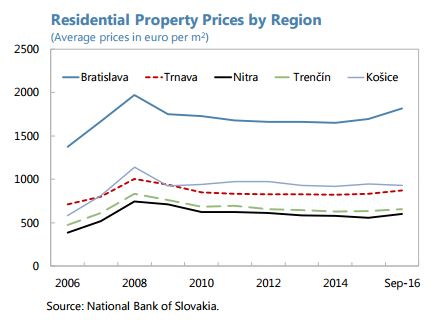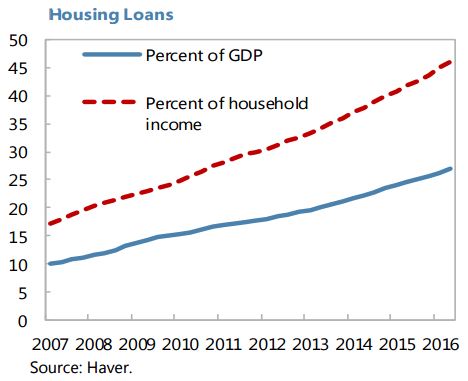Thursday, March 23, 2017
House Prices in Slovak Republic
“House prices have increased in some regions but remain below their pre-crisis levels”, says IMF’s report on Slovak Republic.
The report also say that “The authorities have stepped up macro-prudential measures since 2014 to preserve lending standards and increase buffers. Following the implementation of the Housing Loan Act (HLA) in March 2016, the NBS has a mandate to issue binding decrees imposing limits on debt service to income (DSTI) and LTV ratios which are set to further tighten in 2017.”
“House prices have increased in some regions but remain below their pre-crisis levels”, says IMF’s report on Slovak Republic.
The report also say that “The authorities have stepped up macro-prudential measures since 2014 to preserve lending standards and increase buffers. Following the implementation of the Housing Loan Act (HLA) in March 2016, the NBS has a mandate to issue binding decrees imposing limits on debt service to income (DSTI) and LTV ratios which are set to further tighten in 2017.”
Posted by at 10:35 AM
Labels: Global Housing Watch
Monday, March 20, 2017
Inflation-Forecast Targeting for India
A new IMF working paper studies the Inflation-Forecast Targeting in India. “India formally adopted flexible-inflation targeting (FIT) in June 2016 to place price stability, defined in terms of a target CPI inflation, as the primary objective of the monetary policy. In this context, the paper draws on Indian macro-economic developments since 2000 and the experience of other countries that adopted FIT to bring out insights on how credible policy with an emphasis on strong nominal anchor can reduce the impact of supply shocks and improve macroeconomic stability. For illustrating the key issues given the unique structural characteristics of India and the policy options under an FIT framework, the paper describes an analytical framework using the core Quarterly Projection Model (QPM). Simulation of QPM are carried out to illustrate the monetary policy responses under different types of uncertainty and to bring out the importance of gaining credibility for improving monetary policy efficacy.”

A new IMF working paper studies the Inflation-Forecast Targeting in India. “India formally adopted flexible-inflation targeting (FIT) in June 2016 to place price stability, defined in terms of a target CPI inflation, as the primary objective of the monetary policy. In this context, the paper draws on Indian macro-economic developments since 2000 and the experience of other countries that adopted FIT to bring out insights on how credible policy with an emphasis on strong nominal anchor can reduce the impact of supply shocks and improve macroeconomic stability.
Posted by at 11:12 AM
Labels: Forecasting Forum
Jobs and Happiness
According to a new report by Jan-Emmanuel De Neve and George Ward: “The overwhelming importance of having a job for happiness is evident throughout the analysis, and holds across all of the world’s regions. When considering the world’s population as a whole, people with a job evaluate the quality of their lives much more favorably than those who are unemployed. The importance of having a job extends far beyond the salary attached to it, with non-pecuniary aspects of employment such as social status, social relations, daily structure, and goals all exerting a strong influence on people’s happiness.” Continue reading here.
According to a new report by Jan-Emmanuel De Neve and George Ward: “The overwhelming importance of having a job for happiness is evident throughout the analysis, and holds across all of the world’s regions. When considering the world’s population as a whole, people with a job evaluate the quality of their lives much more favorably than those who are unemployed. The importance of having a job extends far beyond the salary attached to it, with non-pecuniary aspects of employment such as social status,
Posted by at 9:13 AM
Labels: Inclusive Growth
Does Money Buy Happiness? Evidence from China
A new report by Richard Easterlin, a pioneer of the study of the link between income and happiness, looks into whether China’s income growth has made people happier. He writes: “In the past quarter century China’s real GDP per capita has multiplied over five times, an unprecedented feat.1 By 2012 virtually every urban household had, on average, a color TV, air conditioner, washing machine, and refrigerator. Almost nine in ten had a personal computer, and one in five, an automobile. Rural households lagged somewhat behind urban, but these same symptoms of affluence, which were virtually nonexistent in the countryside in 1990, had become quite common by 2012.2 In the face of such new-found plenitude, one would suppose that the population’s feelings of well-being would have enjoyed a similar multiplication. Yet, as will be discussed, well-being today is probably less than in 1990.” The full report is worth reading.
A new report by Richard Easterlin, a pioneer of the study of the link between income and happiness, looks into whether China’s income growth has made people happier. He writes: “In the past quarter century China’s real GDP per capita has multiplied over five times, an unprecedented feat.1 By 2012 virtually every urban household had, on average, a color TV, air conditioner, washing machine, and refrigerator. Almost nine in ten had a personal computer, and one in five,
Posted by at 9:04 AM
Labels: Inclusive Growth
Friday, March 17, 2017
House Prices in Belgium
IMF’s latest report on Belgium says:
“Further macro-prudential actions may be needed to address pockets of vulnerability in the housing market. Concerns relate to the continued growth in house prices, combined with rising household indebtedness and significant shares of risky mortgage lending practices, as well as strong expansion in mortgage credit. Various overvaluation estimates are in the range of 0–20 percent. Policy actions could address these issues from various angles:
Direct remedies. In addition to the existing 5-percentage-point add-on to certain domestic mortgage risk weights, the NBB plans to impose additional capital buffers targeted at riskier loans, i.e. mortgage loans with loan-to-value (LTV) ratio higher than 80 percent, effective May 2017 (pending approval from the European authorities). Staff welcomed these measures and called for continued close monitoring of real estate market developments, including possible search-for-yield behavior in the housing market, and discussed possible further measures such as LTV or debt service to income (DSTI) limits to more directly target vulnerable borrowers.
Other buffers. An additional capital cushion, the capital conservation buffer, will also be raised by 2019 by eight banks deemed domestically systemically important, among which are the large mortgage lenders. Another buffer that could be deployed should strong credit growth persist is the counter-cyclical capital buffer, which is currently set to zero. On balance, staff considers this appropriate, in view of the various estimates of the credit gap of near zero6. Close monitoring is nevertheless warranted.”
IMF’s latest report on Belgium says:
“Further macro-prudential actions may be needed to address pockets of vulnerability in the housing market. Concerns relate to the continued growth in house prices, combined with rising household indebtedness and significant shares of risky mortgage lending practices, as well as strong expansion in mortgage credit. Various overvaluation estimates are in the range of 0–20 percent. Policy actions could address these issues from various angles:
Direct remedies.
Posted by at 5:28 PM
Labels: Global Housing Watch
Subscribe to: Posts








